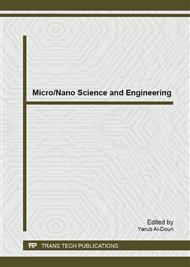[1]
P. V. Kamat, Beyondphotovoltaics: semiconductor nanoarchitectures for liquid-junction solar cells, J. Phys. Chem. C. 111 (2007) 2834–2860.
Google Scholar
[2]
Y. Hou, Y. W. Cheng, T. Hobson and J. Liu, Design and synthesis of hierarchical MnO2 nanospheres/carbon nanotubes/conducting polymer ternary composite for high performance electrochemical electrodes, Nano Lett. 10 (2010) 2727–2733.
DOI: 10.1021/nl101723g
Google Scholar
[3]
L. Wang, H. Liu, R. M. Konik, J. A. Misewich, S.S. Wong, Carbon nanotube-based heterostructures for solar energy applications. Che. Soc. Rev. DOI: 10. 1039/C3CS60088B.
DOI: 10.1039/c3cs60088b
Google Scholar
[4]
M. E. Mann, R. S. Bradley and M. K. Hughes, Global-scale temperature patterns and climate forcing over the past six centuries, Nature 392(1998) 779–787.
DOI: 10.1038/33859
Google Scholar
[5]
T. Umeyama and H. Imahori, Carbon nanotube-modified electrodes for solar energy conversion, Energy Environ. Sci. 1 (2008) 120–133.
DOI: 10.1039/b805419n
Google Scholar
[6]
M. S. Dresselhaus and I. L. Thomas, Alternative energy technologies , Nature 414 (2001) 332–337.
Google Scholar
[7]
E. W. Wong, P. E. Sheehan, C. M. Lieber, Nanobeam mechanics: elasticity, strength, and toughness of nanorods and nanotubes, Science 277 (1997) 1971–(1975).
DOI: 10.1126/science.277.5334.1971
Google Scholar
[8]
J. Hone, B. Batlogg, Z. Benes, A. T. Johnson, J. E. Fischer, Quantized phonon spectrum of single-wall carbon nanotubes, Science 289 (2000) 1730–1733.
DOI: 10.1126/science.289.5485.1730
Google Scholar
[9]
S. J. Tans, A.R.M. Verschueren, C. Dekker, Room-temperature transistor based on a single carbon nanotube, Nature 393 (1998) 49–52.
DOI: 10.1038/29954
Google Scholar
[10]
S. Iijima, Helical microtubules of graphitic carbon, Nature 354 (1991) 56–58.
DOI: 10.1038/354056a0
Google Scholar
[11]
I. A. Levitsky IA, Carbon nanotube hybrids for renewable energy. J NanomedNanotechol 3 (2012) e117.
Google Scholar
[12]
Y. T. Ong, A. L. Ahmad, S.H.S. Zein, S. H. Tan, A review on carbon nanotubes in an environmental protection and green engineering perspective, Braz. J. Chem. Eng. 27 (2010) 227-242.
DOI: 10.1590/s0104-66322010000200002
Google Scholar
[13]
N. S. Lewis, D. G. Nocera, Powering the planet: Chemical challenges in solar energy utilization, Proc. Natl. Acad. Sci. U. S. A. 104 (2007) 20142.
DOI: 10.1073/pnas.0710683104
Google Scholar
[14]
I. Khatri, S. Adhikari, H. R. Aryal, T. Soga, T. Jimbo, M. Umeno, Improving photovoltaic properties by incorporating both single walled carbon nanotubes and functionalized multiwalled carbon nanotubes, App. Phy. Lett. 94(2009) 093509.
DOI: 10.1063/1.3083544
Google Scholar
[15]
Y. Jia, J. Wei, K. Wang, A. Cao,Q. Shu, X. Gui, Y. Zhu, D. Zhuang, G. Zhang, B. Ma, L. Wang, W. Liu, Z. Wang, J. Luo, D. Wu, Nanotube-silicon heterojunction solar cells, Adv. Mater. 20 (2008) 4594.
DOI: 10.1002/adma.200801810
Google Scholar
[16]
E. Shi, L. Zhang, Z. Li, P. Li, Y. Shang, Y. Jia et al., TiO2-Coated Carbon Nanotube-Silicon Solar Cells with Efficiency of 15%, Scientific reports, 2 (2012)Article number: 884, doi: 10. 1038/srep00884.
DOI: 10.1038/srep00884
Google Scholar
[17]
Y. Jung, X. Li, N.K. Rajan, A.D. Taylor, M.A. Reed, Record high efficiency single-walled Carbon Nanotube/Silicon p–n junction solar cells, Nano letters13 (2012) 95-99.
DOI: 10.1021/nl3035652
Google Scholar
[18]
R.A.J. Janssen, J.C. Hummelen N.S. Sariciftci, Polymer-fullerene bulk heterojunction solar cells, MRS Bulletin 30 (2005) 33.
DOI: 10.1557/mrs2005.6
Google Scholar
[19]
A. D. Pasquier, H. E. Unalan, A. Kanwal, S. Miller, M. Chhowalla, Conducting and transparent single-wall carbon nanotube electrodes for polymer–fullerene solar cells, Appl. Phys. Lett. 87 (2005), 203511.
DOI: 10.1063/1.2132065
Google Scholar
[20]
B. J. Landi, R.P. Raffaelle, S. L. Castro, S.G., Single-wall carbon nanotube-polymer solar cells, Prog. Photovoltaics: Res. Appl13 (2005) 165-172.
DOI: 10.1002/pip.604
Google Scholar
[21]
M. W. Rowell, M.A. Topinka, M.D. McGehee, H.J. Prall, G. Dennler, N.S. Sariciftci, L.B. Hu, G. Gruner, Organic solar cells with carbon nanotube network electrodes, Appl. Phys. Lett. 88 (2006) 233506.
DOI: 10.1063/1.2209887
Google Scholar
[22]
S. Cataldo, P. Salice, E. Menna, B. Pignataro, Carbon nanotubes and organic solar cells, Energ. & Environ. Sci. 5 (2012), 5919-5940.
DOI: 10.1039/c1ee02276h
Google Scholar
[23]
P. Brown, K. Takechi, P.V. Kamat, Single-walled carbon nanotube scaffolds for dye-sensitized solar cells, J. Phys. Chem. C. 112 (2008) 4776.
DOI: 10.1021/jp7107472
Google Scholar
[24]
H. W. Zhu, H.F. Zeng, V. Subramanian, C. Masarapu, K.H. Hung, B.Q. Wei, Anthocyanin-sensitized solar cell using carbon nanotube films as counter electrodes, Nanotechnology19 (2008) 465204.
DOI: 10.1088/0957-4484/19/46/465204
Google Scholar
[25]
M. K. Nazeeruddin, F. De Angelis, S. Fantacci, A. Selloni, G. Viscardi, P. Liska, S. Ito, T. Bessho and M. Gratzel, Combined experimental and DFT-TDDFT computational study of photoelectrochemical cell ruthenium sensitizers, J. Am. Chem. Soc. 127 (2005).
DOI: 10.1021/ja052467l
Google Scholar


